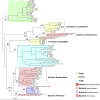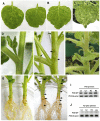Identification and characterization of the first pectin methylesterase gene discovered in the root lesion nematode Pratylenchus penetrans
- PMID: 30794636
- PMCID: PMC6386239
- DOI: 10.1371/journal.pone.0212540
Identification and characterization of the first pectin methylesterase gene discovered in the root lesion nematode Pratylenchus penetrans
Erratum in
-
Correction: Identification and characterization of the first pectin methylesterase gene discovered in the root lesion nematode Pratylenchus penetrans.PLoS One. 2019 Mar 18;14(3):e0214185. doi: 10.1371/journal.pone.0214185. eCollection 2019. PLoS One. 2019. PMID: 30883610 Free PMC article.
Abstract
Similar to other plant-parasitic nematodes, root lesion nematodes possess an array of enzymes that are involved in the degradation of the plant cell wall. Here we report the identification of a gene encoding a cell wall-degrading enzyme, pectin methylesterase PME (EC 3.1.1.11), in the root lesion nematode Pratylenchus penetrans. Both genomic and coding sequences of the gene were cloned for this species, that included the presence of four introns which eliminated a possible contamination from bacteria. Expression of the Pp-pme gene was localized in the esophageal glands of P. penetrans as determined by in situ hybridization. Temporal expression of Pp-pme in planta was validated at early time points of infection. The possible function and activity of the gene were assessed by transient expression of Pp-pme in plants of Nicotiana benthamiana plants via a Potato virus X-based vector. To our knowledge, this is the first report on identification and characterization of a PME gene within the phylum Nematoda.
Conflict of interest statement
The authors have declared that no competing interests exist.
Figures







Similar articles
-
A new esophageal gland transcriptome reveals signatures of large scale de novo effector birth in the root lesion nematode Pratylenchus penetrans.BMC Genomics. 2020 Oct 23;21(1):738. doi: 10.1186/s12864-020-07146-0. BMC Genomics. 2020. PMID: 33096989 Free PMC article.
-
The Root Lesion Nematode Effector Ppen10370 Is Essential for Parasitism of Pratylenchus penetrans.Mol Plant Microbe Interact. 2021 Jun;34(6):645-657. doi: 10.1094/MPMI-09-20-0267-R. Epub 2021 Apr 12. Mol Plant Microbe Interact. 2021. PMID: 33400561
-
An Expansin-Like Candidate Effector Protein from Pratylenchus penetrans Modulates Immune Responses in Nicotiana benthamiana.Phytopathology. 2020 Mar;110(3):684-693. doi: 10.1094/PHYTO-09-19-0336-R. Epub 2020 Jan 14. Phytopathology. 2020. PMID: 31680651
-
Pectin methylesterase and its proteinaceous inhibitor: a review.Carbohydr Res. 2010 Dec 10;345(18):2583-95. doi: 10.1016/j.carres.2010.10.002. Epub 2010 Nov 1. Carbohydr Res. 2010. PMID: 21047623 Review.
-
Pectin methylesterase inhibitor.Biochim Biophys Acta. 2004 Feb 12;1696(2):245-52. doi: 10.1016/j.bbapap.2003.08.011. Biochim Biophys Acta. 2004. PMID: 14871665 Review.
Cited by
-
Correction: Identification and characterization of the first pectin methylesterase gene discovered in the root lesion nematode Pratylenchus penetrans.PLoS One. 2019 Mar 18;14(3):e0214185. doi: 10.1371/journal.pone.0214185. eCollection 2019. PLoS One. 2019. PMID: 30883610 Free PMC article.
-
Functional Carbohydrate-Active Enzymes Acquired by Horizontal Gene Transfer from Plants in the Whitefly Bemisia tabaci.Genome Biol Evol. 2025 Feb 3;17(2):evaf012. doi: 10.1093/gbe/evaf012. Genome Biol Evol. 2025. PMID: 39862048 Free PMC article.
-
A new esophageal gland transcriptome reveals signatures of large scale de novo effector birth in the root lesion nematode Pratylenchus penetrans.BMC Genomics. 2020 Oct 23;21(1):738. doi: 10.1186/s12864-020-07146-0. BMC Genomics. 2020. PMID: 33096989 Free PMC article.
-
Pectin modifications promote haustoria development in the parasitic plant Phtheirospermum japonicum.Plant Physiol. 2023 Dec 30;194(1):229-242. doi: 10.1093/plphys/kiad343. Plant Physiol. 2023. PMID: 37311199 Free PMC article.
-
Advances in Migratory Plant Endoparasitic Nematode Effectors.Int J Mol Sci. 2024 Jun 11;25(12):6435. doi: 10.3390/ijms25126435. Int J Mol Sci. 2024. PMID: 38928141 Free PMC article. Review.
References
Publication types
MeSH terms
Substances
LinkOut - more resources
Full Text Sources
Molecular Biology Databases
Research Materials
Miscellaneous

